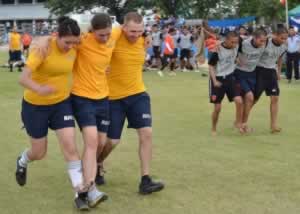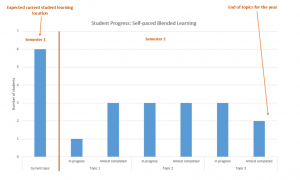Traditional teaching usually keeps all students at the same learning position. This is unnatural.
 Self-paced blended learning continues to produce amazing results.
Self-paced blended learning continues to produce amazing results.
As self-paced courses “mature,” they continue to improve; resources get fine-tuned and teachers become comfortable and confident with the new methods of learning. This makes the courses feel complete and ‘natural’ to students.
If teachers don’t tell them, students don’t realize what pace of learning is “normal” or expected, and thus they learn at a pace appropriate to each individual… and in these courses the pace is accelerating.
The graph below shows the “distribution of learning” in a middle school technology class. As Semester 1 draws to a close, some students have almost completed the learning for Semester 2. (There are three topics in Semester 2 of this course. The graph shows those students who are currently studying a particular topic and those who have almost completed the topic.)
(Next page: Addressing self-paced learning concerns)
Of course, this situation is possible only because students were able to work at their own pace during Semester 1.
Some teachers of traditional subjects become concerned with this “spread of learning.” However, many of their concerns relate to management of students rather than student learning, or are simply misinformed, and can be easily solved.
Some are concerned that self-paced courses are pushing students academically. This is far from reality; no “pushing” has occurred. Students have simply been provided with a clear path of learning with all of the necessary learning materials available and with plenty of support; they then chose their pace of learning.
Some teachers may be concerned that “the computer does the teaching” and thus students are losing out on interaction with the teacher. Once again, this is far from the reality of the situation. Teacher student interaction is a vital and rich component of these courses. However, the interaction tends to be mainly individual or in small groups, and is specific to the needs of the individual/s rather than the general needs of a group. Thus, the interaction is often richer than in a traditional class.
What these courses have created is “normal.” We haven’t accelerated learning; we have simply removed barriers so that students have the freedom to work at a pace that is natural for them.
Traditional teaching usually keeps all students at the same learning position. This is unnatural. It promotes decelerated learning; just because it has been happening for decades and appears to be normal, and that educators were unable to create alternatives, doesn’t mean that it should remain that way. Technology has the ability to remove “decelerated teaching”; it has made us realize that what we considered normal was slowing student learning. However, until recently, there was nothing to compare this rate of learning to, so it wasn’t obvious that it was decelerated learning.
Everyone is familiar with a three legged race. Two people have a leg tied together so that they have to run at the same speed. The faster person has to slow down, and the slower one has to try to keep up. The end result is an average speed that neither is comfortable with. A four legged race, involving three individuals, is even more problematic.

Imagine a larger combination of people, with all the students in your class tied together in a similar fashion to make one large “thirty legged race,” where everyone is joined and all must run at the same pace. Is it any wonder that sometimes people just fall over? Learning should not be like this.
It is time we leveraged technology to remove decelerated teaching. It is time we allowed student to enter to the world of natural paced learning.
We finally have the technology to make this possible and it would be wrong not to use it.
Peter West is Director of eLearning at Saint Stephen’s College in Australia. He has over 15 years’ experience leading K-12 schools in technology enhanced education, particularly blended learning using online learning environments. He can be contacted at pwest@ssc.qld.edu.au.
- The traditional classroom works so why change it? - February 23, 2017
- Are outdated computers reverting students to a prehistoric era? - November 17, 2016
- Blended learning and the paradox of the experienced teacher - September 30, 2014

